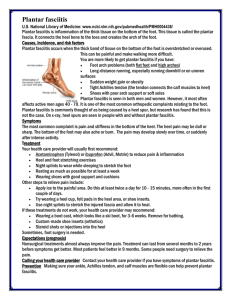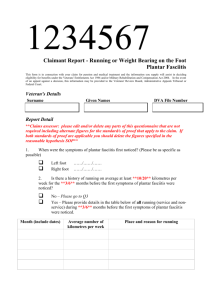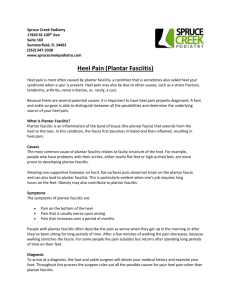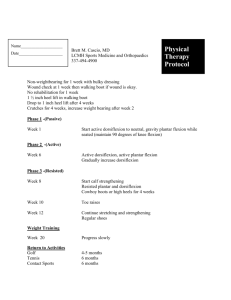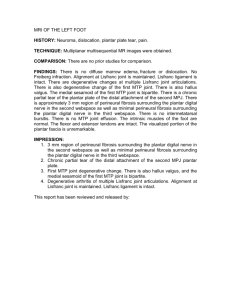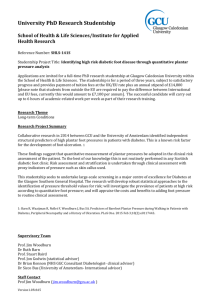51/2015 - Repatriation Medical Authority
advertisement
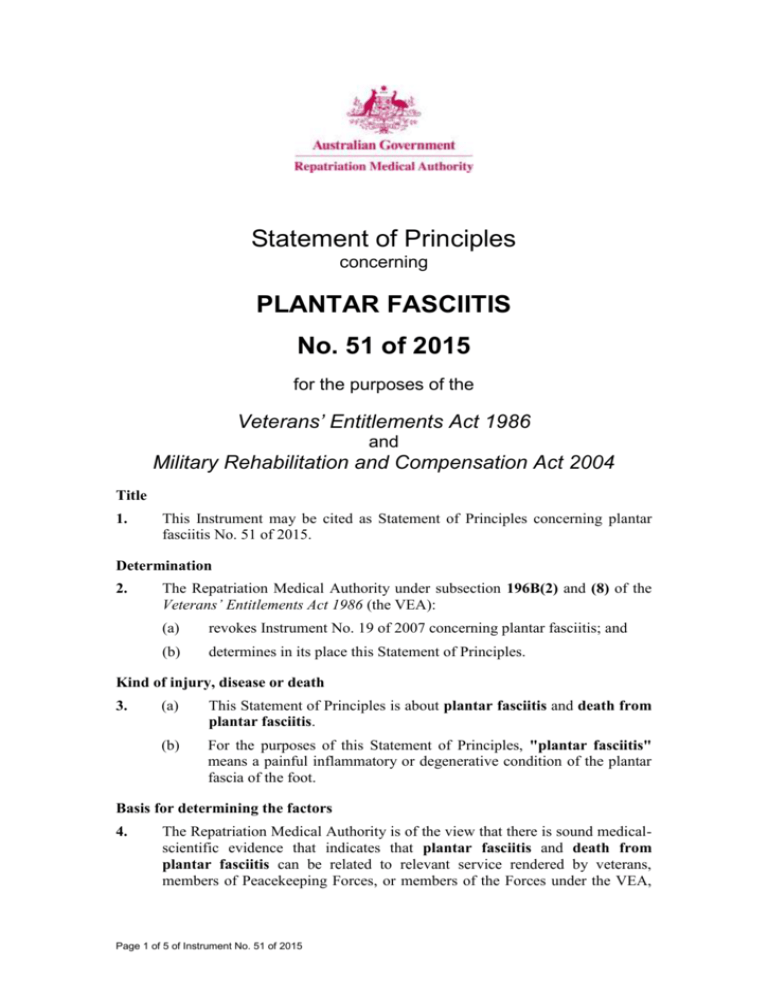
Statement of Principles concerning PLANTAR FASCIITIS No. 51 of 2015 for the purposes of the Veterans’ Entitlements Act 1986 and Military Rehabilitation and Compensation Act 2004 Title 1. This Instrument may be cited as Statement of Principles concerning plantar fasciitis No. 51 of 2015. Determination 2. The Repatriation Medical Authority under subsection 196B(2) and (8) of the Veterans’ Entitlements Act 1986 (the VEA): (a) revokes Instrument No. 19 of 2007 concerning plantar fasciitis; and (b) determines in its place this Statement of Principles. Kind of injury, disease or death 3. (a) This Statement of Principles is about plantar fasciitis and death from plantar fasciitis. (b) For the purposes of this Statement of Principles, "plantar fasciitis" means a painful inflammatory or degenerative condition of the plantar fascia of the foot. Basis for determining the factors 4. The Repatriation Medical Authority is of the view that there is sound medicalscientific evidence that indicates that plantar fasciitis and death from plantar fasciitis can be related to relevant service rendered by veterans, members of Peacekeeping Forces, or members of the Forces under the VEA, Page 1 of 5 of Instrument No. 51 of 2015 or members under the Military Rehabilitation and Compensation Act 2004 (the MRCA). Factors that must be related to service 5. Subject to clause 7, at least one of the factors set out in clause 6 must be related to the relevant service rendered by the person. Factors 6. The factor that must as a minimum exist before it can be said that a reasonable hypothesis has been raised connecting plantar fasciitis or death from plantar fasciitis with the circumstances of a person’s relevant service is: (a) having trauma to the plantar aspect of the affected foot between two and seven days before the clinical onset of plantar fasciitis; or (b) having an infection involving the plantar fascia at the time of the clinical onset of plantar fasciitis; or (c) running or jogging an average of at least 30 kilometres per week for the three months before the clinical onset of plantar fasciitis; or (d) undertaking exercise, at a rate of at least five METS, that involves repetitive weight bearing on the affected foot, for at least four hours per week for the three months before the clinical onset of plantar fasciitis; or (e) increasing the frequency, duration, or intensity of weight bearing activity involving the affected foot by at least 100 percent, to a minimum intensity of five METs for at least two hours per day, within the seven days before the clinical onset of plantar fasciitis; or (f) undergoing prolonged weight bearing on the affected foot while on a hard surface for at least five hours per day, on more days than not, for the six months before the clinical onset of plantar fasciitis; or (g) being obese at the time of the clinical onset of plantar fasciitis; or (h) having a systemic arthritic disease at the time of the clinical onset of plantar fasciitis; or (i) having an acquired biomechanical abnormality involving the affected foot before the clinical onset of plantar fasciitis; or (j) wearing inappropriate footwear during weight bearing exercise which involves the affected foot within the seven days before the clinical onset of plantar fasciitis; or (k) having trauma to the plantar aspect of the affected foot between two and seven days before the clinical worsening of plantar fasciitis; or (l) having an infection involving the plantar fascia at the time of the clinical worsening of plantar fasciitis; or (m) running or jogging an average of at least 30 kilometres per week for the three months before the clinical worsening of plantar fasciitis; or Page 2 of 5 of Instrument No. 51 of 2015 (n) undertaking exercise, at a rate of at least five METS, that involves repetitive weight bearing on the affected foot, for at least four hours per week for the three months before the clinical worsening of plantar fasciitis; or (o) increasing the frequency, duration, or intensity of weight bearing activity involving the affected foot by at least 100 percent, to a minimum intensity of five METs for at least two hours per day, within the seven days before the clinical worsening of plantar fasciitis; or (p) undergoing prolonged weight bearing on the affected foot while on a hard surface for at least five hours per day, on more days than not, for the six months before the clinical worsening of plantar fasciitis; or (q) being obese at the time of the clinical worsening of plantar fasciitis; or (r) having a systemic arthritic disease at the time of the clinical worsening of plantar fasciitis; or (s) having an acquired biomechanical abnormality involving the affected foot before the clinical worsening of plantar fasciitis; or (t) wearing inappropriate footwear during weight bearing exercise which involves the affected foot within the seven days before the clinical worsening of plantar fasciitis; or (u) inability to obtain appropriate clinical management for plantar fasciitis. Factors that apply only to material contribution or aggravation 7. Paragraphs 6(k) to 6(u) apply only to material contribution to, or aggravation of, plantar fasciitis where the person’s plantar fasciitis was suffered or contracted before or during (but not arising out of) the person’s relevant service. Inclusion of Statements of Principles 8. In this Statement of Principles if a relevant factor applies and that factor includes an injury or disease in respect of which there is a Statement of Principles then the factors in that last mentioned Statement of Principles apply in accordance with the terms of that Statement of Principles as in force from time to time. Other definitions 9. For the purposes of this Statement of Principles: "a systemic arthritic disease" means: (a) ankylosing spondylitis; (b) crystal-induced arthropathy; (c) enteropathic spondyloarthropathy; (d) psoriatic arthropathy; (e) reactive arthritis; or (f) undifferentiated spondyloarthropathy; Page 3 of 5 of Instrument No. 51 of 2015 "being obese" means having a Body Mass Index (BMI) of 30 or greater. The BMI = W/H2 and where: W is the person's weight in kilograms; and H is the person's height in metres; "biomechanical abnormality" means injury or disease that has resulted in overpronation or underpronation, or decreased ankle or forefoot flexibility; "crystal-induced arthropathy" means arthropathy resulting from the deposition of monosodium urate, calcium pyrophosphate dihydrate, calcium hydroxyapatite or calcium oxalate; "death from plantar fasciitis" in relation to a person includes death from a terminal event or condition that was contributed to by the person’s plantar fasciitis; "hard surface" means a paved road surface or the equivalent; "inappropriate footwear" means footwear that has inadequate cushioning; "MET" means a unit of measurement of the level of physical exertion. 1 MET = 3.5 ml of oxygen/kg of body weight per minute, or 1.0 kcal/kg of body weight per hour, or resting metabolic rate; "relevant service" means: (a) operational service under the VEA; (b) peacekeeping service under the VEA; (c) hazardous service under the VEA; (d) British nuclear test defence service under the VEA; (e) warlike service under the MRCA; or (f) non-warlike service under the MRCA; "terminal event" means the proximate or ultimate cause of death and includes: (a) pneumonia; (b) respiratory failure; (c) cardiac arrest; (d) circulatory failure; or (e) cessation of brain function. Application 10. This Instrument applies to all matters to which section 120A of the VEA or section 338 of the MRCA applies. Page 4 of 5 of Instrument No. 51 of 2015 Date of effect 11. This Instrument takes effect from 30 March 2015. Dated this twenty-seventh The Common Seal of the Repatriation Medical Authority was affixed at the direction of: day of February 2015 ) ) ) PROFESSOR NICHOLAS SAUNDERS AO CHAIRPERSON Page 5 of 5 of Instrument No. 51 of 2015
